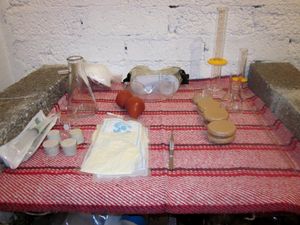
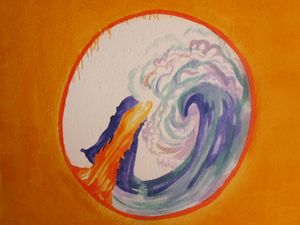
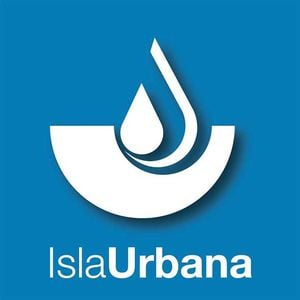
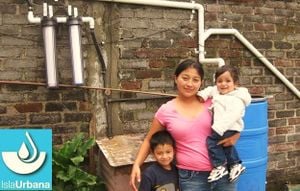
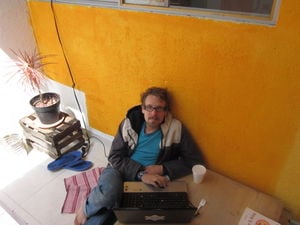
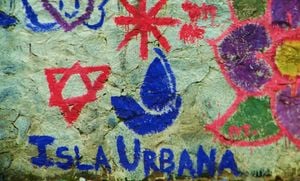
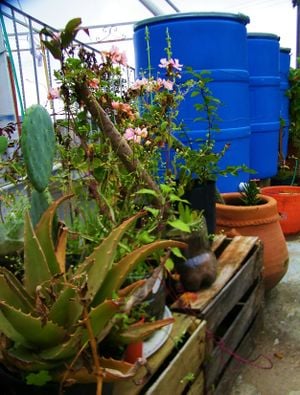
The following is a list of goals, test procedures, survey questions, equipment needed, and abstracts for testing water quality, surveying water access, and mapping high risk areas with little to no access to clean water. This is one test in a series of tests of rainwater, grid water, and store bought garafon drinking water quality at The Laboratory of Community Alternative Technologies at Ajusco in conjunction with Isla Urbana. Both groups are non profits in association with International Renewable Resources Institute-Mexico located in Mexico City. Isla Urbana is a group providing rainwater catchment systems around Mexico City and other areas of Mexico, Ajusco Labs is a laboratory testing center for appropriate technology projects and outcomes. Ajusco Labs will be testing rainwater quality outcomes from Isla Urbanas systems set up around Mexico City. This is one part in a series of rainwater testing at Isla Urbana and Ajusco Labs. Click here to connect to the main page on Rainwater quality testing.
Abstract[edit | edit source]
In many cities around the world one quarter of the households have no access to drinking water within 200 meters from their household.[1] Access to water resources are expected to come under increasing pressure with global climate change and rapidly increasing city populations in the developing world.[2] The lack of access to water not only has an effect on health and economic hardship, but on peoples perceived quality of life.[3] Rainwater collection is an alternative option when there is a lack of access to municipal supplies or clean water supplies. Though rainwater is relatively free of impurities there are sources of contamination found from the atmosphere, human uses of the surrounding land, organic matter and animal droppings entering the system, and possible pollutants from system materials.[4] Our study tests the water quality in real rain harvesting systems set up by Isla Urbana in Mexico City and surveys families on how water access affects their quality of life. We will take samples from the cistern, faucet, and grid water in order to test for contaminants including: coliforms, Chemical Oxygen Demand (COD), Total Organic Carbons (TOC), Dissolved Organic Carbon (DOC), Total Suspended Solids (TSS), Nitrates, and Hardness. We will also survey the families to find out how water access affects their lives by finding out: how often they buy water garafons for drinking, their income level, if they've had access to municipal water during the month, as well as making observations on how low the tank is. At least 16 families over the course of the year will be included in the study, 4 without rain catchment systems, and water quality results will be compared against both water portability standards. Also in order to address high risk areas in the area we will be mapping the location of sample sites and results. Our mapping will help us understand the geographic influences on rainwater quality and water access found in Isla Urbana's rain harvesting systems around Mexico City.
rainwater, water quality, contamination, Mexico City, mapping
Background[edit | edit source]
Access to clean water is already limited, with1.2 billion people around the world lacking access to a reliable source of water reasonably protected from contamination.[5] Decreasing access to clean water is expected as city populations continue to grow rapidly and its projected that by 2030, the urban population will grow to 3.3 billion, with 90 percent of the growth in developing countries..[6] Lack of access to clean water can easily result in water born diseases and households without access to potable water have been associated with higher child mortality..[7] Diarrhea alone kills 1 child every 30 seconds.[8] Today some governments are turning to rainwater collection systems to help provide water that the municipal grid water can not supply. Whether people are lacking access to water or desire cleaner water then what is available, rainwater is being increasingly accepted as an integral household and community addition.
Cultura Maya, one of our study sites with rain catchment systems, was originally a group of illegal settlements built in the 80s on the outskirts of Mexico City and burnt down twice. Now homes and families are well established, but access to improved sewer systems are non existant and access to municipal water varies, with some having no access and others having their municipal water supply contaminated by self built septic systems close to their municipal water pipes.
Isla Urbanas systems are currently only suggested for domestic use, but we hope to find if the ending water quality meets drinking water standards. Isla Urbanas rain water catchments are designed to utilize parts of the existing water delivery infrastructure in homes including the cistern and rooftop tank for supplying water pressure. Most roofs are cement and the first 208 L of rain runs off into a first flush to remove contaminants that may have settled on the roof. The remaining rain enters a cistern that is sometimes shared with the municipal water, when needed water is pumped through two filters, the first removes sediments, the second is a carbon filter that can remove many contaminants. Water then goes to the rooftop tank which helps supply water pressure for household use. We will study the stored water from the cistern and the rooftop tanks to see if they meet drinking water standards. We will also compare these results to tests of both municipal grid supply water and the garafon drinking water commonly sold here.
Goals[edit | edit source]
- Tells us the water quality of rainwater systems, grid water, and bought garafon drinking water.
- Tells us how water access affects people's lives.
- Understand the money that families typically allocat to rent verse garafon drinking water and grid water
- Understand what percent of total family income is allocated to drinking water and grid water
Equipment[edit | edit source]
- 2 sterilized 500ml sample jars
- Icebox for storing fresh samples
- Ice to put in icebox
- Equipment and reagents as specified in the colorimeter manual for each parameter
Test Timing within the Year[edit | edit source]
Can be done year around, the Length is for one year, take samples of each family once a month
Sampling Sites[edit | edit source]
- In Cistern: Stored water in System
In order to understand the effects of storing water before filtering and the effects of grid water mixing with rainwater on ending water quality.
Frequency: every time it has some portion of rainwater
- Faucet: Exiting end use water
In order to understand end use water quality in rainwater systems.
Frequency: every time it has some portion of rainwater
- Municipal water supply before entering cistern
In order to understand grid quality and address high risk areas needing rainwater systems
Frequency: every time their is access. There should be access to the municipal water supply in the cistern.
- rooftop tank that delivers water pressure
In order to understand the effects of storing water after filtration. Frequency: every time.
Process[edit | edit source]
Water quality Sampling[edit | edit source]
- Collect 1 sample from the cistern in a 500ml container or larger, label and write the date.
- Ask and write down if the cistern has a combination of grid water and rainwater, just rainwater, or just grid water,
- Collect 1 sample from a faucet connected to the cistern in a 500 ml container or larger.
- Ask and write down if the faucet is used for the washing clothes, cooking, bathing, or etc.
- Lastly turn on the municipal supply into the cistern and take a sample in a 500 ml container.
- Place samples in an icebox with ice until you can either test or place them in a refrigerator.
- Test samples along the parameters in Section 2, parameters will be tested according to the colorimeter manual.
- For coliform testing samples must be tested within 6 hours.
- Reagents used in the testing may be toxic and will need careful disposal, check the colorimeter manual for proper disposal and locations and contact information for the proper disposal organizations.
Survey[edit | edit source]
Ask the following questions after sampling
- How many Garafons have they had to buy in the last month
- Money spent on garafones
- Money spent on grid water bill
- Money spent on rent
- Total income of family this month
- Note the cistern level (use increments of 10%)
- Ask if their cistern is mostly full of rainwater/ grid water/ or a mixture
- How much grid water have they had?
- How much rainwater have they had?
- What are their feelings are about their level of access to water? From 1 to 5; 5 very satisfied, 4 slightly satisfied, 3 ok, 2 slightly problematic, and 1 very distressful.
- Have they run out of water this month?
- How many days were they without water?
- What is their perceived water quality? From 1 to 5; 5 very satisfied, 4 slightly satisfied, 3 ok, 2 slightly problematic, and 1 very distressful
- What do they use their rainwater for?
- What do they use their grid water for?
- Do you have a septic tank?
- Have you smelt a septic overflow around your house this month?
- How many days ago did the smell stop?
One time initial questions:
- Do you have an open dump close to your house?
- Do you have cats or dogs on your roof?
- Document their elevation from Gps
- Document location on Gps
- Do they boil grid water before drinking?
- Do they boil rainwater before drinking?
Results[edit | edit source]
In process, this is a year long study starting this November 1, 2010.
References[edit | edit source]
- ↑ Anqing Shi, How Access to Urban Potable Water and Sewerage Connections Affects Child Mortality, Finance Development Research Group, World Bank, http://www-wds.worldbank.org/external/default/WDSContentServer/IW3P/IB/2000/02/14/000094946_0001290532173/additional/121521322_20041117153044.pdf
- ↑ United Nations. UN Global Compact: Climate Change and the Global Water Crisis. May, 2009. http://www.unglobalcompact.org/docs/issues_doc/Environment/ceo_water_mandate/UNGC-PI_climate-water_whitepaper_FINAL.pdf
- ↑ M. Joseph Sirgy, Rhonda Phillips, D. Rahtz. Community Quality-of-Life Indicators: Best Cases IV. Springer. London, 2009. pg 194.
- ↑ Dillaha, Theo A. III, and Zolan, William J. Rainwater catchment water quality in Micronesia. Water Research. Vol. 19, no. 6, 1985, pp. 741-746.
- ↑ United Nations. World View: 2004 World Develoment Indicators. 2004. http://web.archive.org/web/20081117014412/http://www.un.org/special-rep/ohrlls/ldc/Global-Reports/WDI%20Section1-intro.pdf
- ↑ Anqing Shi, How Access to Urban Potable Water and Sewerage Connections Affects Child Mortality, Finance Development Research Group, World Bank, http://www-wds.worldbank.org/external/default/WDSContentServer/IW3P/IB/2000/02/14/000094946_0001290532173/additional/121521322_20041117153044.pdf
- ↑ Anqing Shi, How Access to Urban Potable Water and Sewerage Connections Affects Child Mortality, Finance Development Research Group, World Bank, http://www-wds.worldbank.org/external/default/WDSContentServer/IW3P/IB/2000/02/14/000094946_0001290532173/additional/121521322_20041117153044.pdf
- ↑ Saghir, Jamal and Baudouy, Jacques. The Handwashing Handbook: A guide for developing a hygiene promotion program to increase handwashing with soap. http://www.globalhandwashing.org/